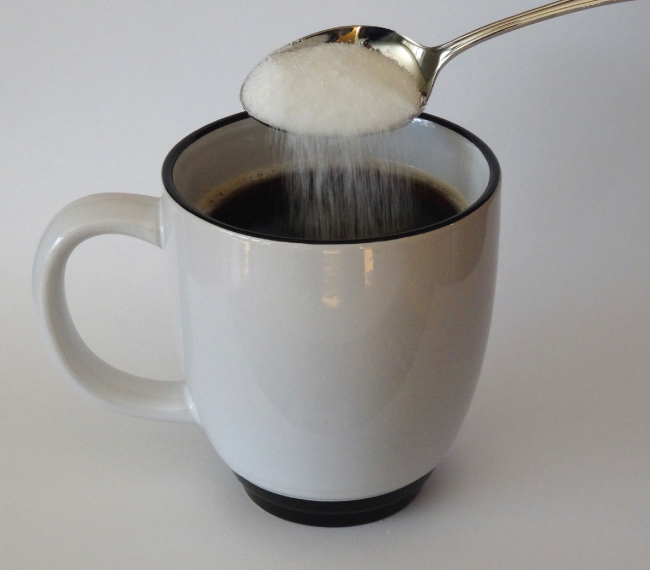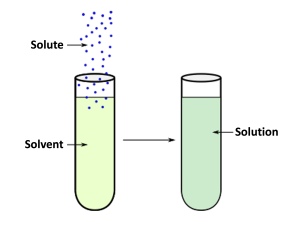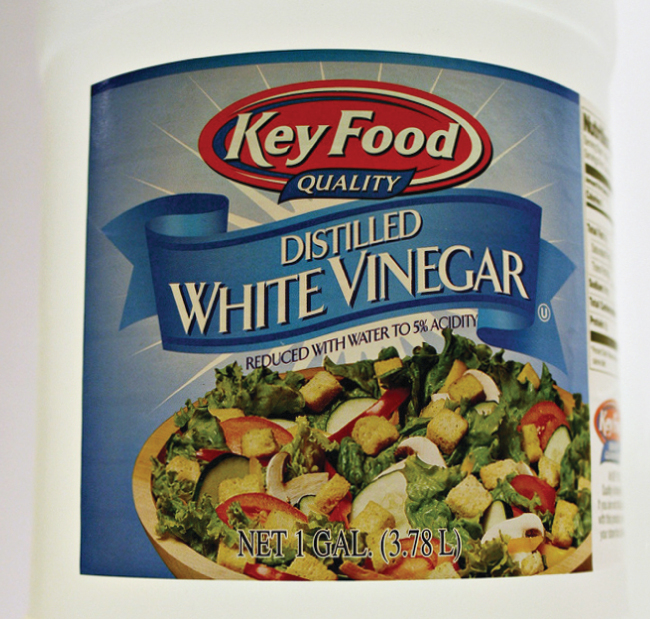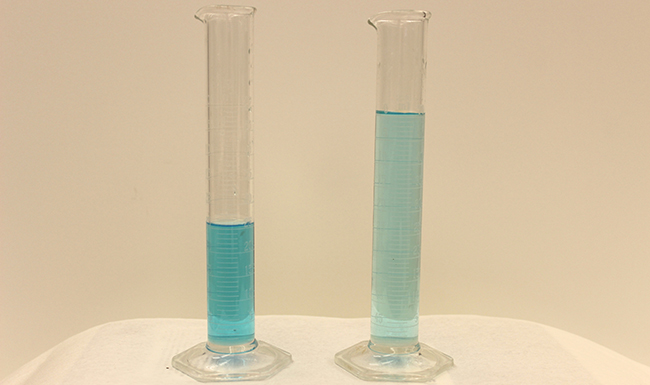Chapter 3 Composition of Substances and Solutions
3.3 Molarity
Learning Objectives
By the end of this section, you will be able to:
- Describe the fundamental properties of solutions
- Calculate solution concentrations using molarity
- Perform dilution calculations using the dilution equation
Proceeding sections of this chapter focused on the composition of substances: samples of matter that contain only one type of element or compound. However, mixtures—samples of matter containing two or more substances physically combined—are more commonly encountered in nature than are pure substances. Similar to a pure substance, the relative composition of a mixture plays an important role in determining its properties. The relative amount of oxygen in a planet's atmosphere determines its ability to sustain aerobic life. The relative amounts of iron, carbon, nickel, and other elements in steel (a mixture known as an "alloy") determine its physical strength and resistance to corrosion. The relative amount of the active ingredients in a medicine determines its effectiveness in achieving the desired pharmacological effect. The relative amount of sugar in a beverage determines its sweetness (Figure 3.14). This section will describe one of the most common ways in which the relative compositions of mixtures may be quantified.

Solutions
Solutions have previously been defined as homogeneous mixtures, meaning that the composition of the mixture (and therefore its properties) is uniform throughout its entire volume. Solutions occur frequently in nature and have also been implemented in many forms of manmade technology. A more thorough treatment of solution properties is provided in the chapter on solutions and colloids, but provided here is an introduction to some of the basic properties of solutions.
The relative amount of a given solution component is known as its concentration. Often, though not always, a solution contains one component with a concentration that is significantly greater than that of all other components. This component is called the solvent and may be viewed as the medium in which the other components are dispersed, or dissolved. Solutions in which water is the solvent are, of course, very common on our planet. A solution in which water is the solvent is called an aqueous solution.
A solute is a component of a solution that is typically present at a much lower concentration than the solvent (Figure 3.15). Solute concentrations are often described with qualitative terms such as dilute (of relatively low concentration) and concentrated (of relatively high concentration).

Concentrations may be quantitatively assessed using a wide variety of measurement units, each convenient for particular applications. Molarity is a useful concentration unit for many applications in chemistry. Molarity (M) is defined as the number of moles of solute in exactly 1 liter (1 L) of the solution. It can be calculated by dividing the moles of solute (n) by the volume of the solution (V) in liter:
A 355-mL soft drink sample contains 0.133 mol of sucrose (table sugar). What is the molar concentration of sucrose in the beverage?
Solution
Since the molar amount of solute and the volume of solution are both given, the molarity can be calculated using the definition of molarity. Per this definition, the solution volume must be converted from mL to L:
Check Your Learning
Example 3.15 − Deriving Moles and Volumes from Molar Concentrations
How much sugar (in mols) is contained in a modest sip (~10 mL) of the soft drink from Example 3.14?
Solution
Rearrange the definition of molarity to isolate the quantity sought, moles of sugar, then substitute the value for molarity derived in Example 3.14, 0.375 M:
Check Your Learning
Example 3.16 − Calculating Molar Concentrations from the Mass of Solute
Distilled white vinegar (Figure 3.16) is a solution of acetic acid, CH3CO2H, in water. A 0.500-L vinegar solution contains 25.2 g of acetic acid. What is the concentration of the acetic acid solution in units of molarity?

Solution
As in previous examples, the definition of molarity is the primary equation used to calculate the quantity sought. Since the mass of solute is provided instead of its molar amount, use the solute’s molar mass to obtain the amount of solute in moles:
Check Your Learning
Example 3.17 − Determining the Mass of Solute in a Given Volume of Solution
How many grams of NaCl are contained in 0.250 L of a 5.30 M solution?
Solution
The volume and molarity of the solution are specified, so the amount (mol) of solute is easily computed as demonstrated in Example 3.15:
Finally, this molar amount is used to derive the mass of NaCl:
Check Your Learning
When performing calculations stepwise, as in Example 3.17, it is important to refrain from rounding any intermediate calculation results, which can lead to rounding errors in the final result. In Example 3.17, the molar amount of NaCl computed in the first step, 1.325 mol, would be properly rounded to 1.32 mol if it were to be reported; however, although the last digit (5) is not significant, it must be retained as a guard digit in the intermediate calculation. If the guard digit had not been retained, the final calculation for the mass of NaCl would have been 77.1 g, a difference of 0.3 g.
In addition to retaining a guard digit for intermediate calculations, rounding errors may also be avoided by performing computations in a single step (Example 3.18). This eliminates intermediate steps so that only the final result is rounded.
Example 3.18 − Determining the Volume of Solution Containing a Given Mass of Solute
In Example 3.16, the concentration of acetic acid in white vinegar was determined to be 0.839 M. What volume of vinegar contains 75.6 g of acetic acid?
Solution
First, use the molar mass to calculate moles of acetic acid from the given mass:
Then, use the molarity of the solution to calculate the volume of solution containing this molar amount of solute:
Combining these two steps into one yields:
Note that we are using the reciprocal of the molar mass (mols/g) in the first step and the reciprocal of the molarity (L/mol) in the second step. You can accomplish this in your calculator by dividing by molar mass and molarity rather than multiplying.
Check Your Learning
Dilution of Solutions
Dilution is the process whereby the concentration of a solution is lessened by the addition of solvent. For example, a glass of iced tea becomes increasingly diluted as the ice melts. The water from the melting ice increases the volume of the solvent (water) and the overall volume of the solution (iced tea), thereby reducing the relative concentrations of the solutes that give the beverage its taste (Figure 3.17).

Dilution is also a common means of preparing solutions of a desired concentration. By adding solvent to a measured portion of a more concentrated stock solution, a solution of lesser concentration may be prepared. For example, commercial pesticides are typically sold as solutions in which the active ingredients are far more concentrated than is appropriate for their application. Before they can be used on crops, the pesticides must be diluted. This is also a very common practice for the preparation of a number of common laboratory reagents.
A simple mathematical relationship can be used to relate the volumes and concentrations of a solution before and after the dilution process. According to the definition of molarity, the number of moles of solute in a solution (n) is equal to the product of the solution’s molarity (M) and its volume in liters (L):
Expressions like these may be written for a solution before and after it is diluted:
where the subscripts “1” and “2” refer to the solution before and after the dilution, respectively. Since the dilution process does not change the amount of solute in the solution, n1 = n2. Thus, these two equations may be set equal to one another:
This relation is commonly referred to as the dilution equation. Although this equation uses molarity as the unit of concentration and liters as the unit of volume, other units of concentration and volume may be used as long as the units properly cancel per the factor-label method. Reflecting this versatility, the dilution equation is often written in the more general form:
Link to Learning
Use the simulation to explore the relations between solute amount, solution volume, and concentration and to confirm the dilution equation.
Example 3.19 − Determining the Concentration of a Diluted Solution
If 0.850 L of a 5.00-M solution of copper nitrate, Cu(NO3)2, is diluted to a volume of 1.80 L by the addition of water, what is the molarity of the diluted solution?
Solution
The stock concentration, C1, and volume, V1, are provided as well as the volume of the diluted solution, V2. Rearrange the dilution equation to isolate the unknown property, the concentration of the diluted solution, C2:
Since the stock solution is being diluted by more than two-fold (volume is increased from 0.85 L to 1.80 L), the diluted solution’s concentration is expected to be less than one-half 5 M. This ballpark estimate will be compared to the calculated result to check for any gross errors in computation (for example, such as an improper substitution of the given quantities). Substituting the given values for the terms on the right side of this equation yields:
This result compares well to our ballpark estimate (it’s a bit less than half the stock concentration, 5 M).
Check Your Learning
Example 3.20 − Volume of a Diluted Solution
What volume of 0.12 M HBr can be prepared from 11 mL (0.011 L) of 0.45 M HBr?
Solution
Provided are the volume and concentration of a stock solution, V1 and C1, and the concentration of the resultant diluted solution, C2. Find the volume of the diluted solution, V2 by rearranging the dilution equation to isolate V2:
Since the diluted concentration (0.12 M) is slightly more than one-fourth the original concentration (0.45 M), the volume of the diluted solution is expected to be roughly four times the original volume, or around 44 mL. Substituting the given values and solving for the unknown volume yields:
The volume of the 0.12-M solution is 0.041 L (41 mL). The result is reasonable and compares well with the rough estimate.
Check Your Learning
Example 3.21 − Volume of a Concentrated Solution Needed for Dilution
What volume of 1.59 M KOH is required to prepare 5.00 L of 0.100 M KOH?
Solution
Given are the concentration of a stock solution, C1, and the volume and concentration of the resultant diluted solution, V2 and C2. Find the volume of the stock solution, V1 by rearranging the dilution equation to isolate V1:
Since the concentration of the diluted solution 0.100 M is roughly one-sixteenth that of the stock solution (1.59 M), the volume of the stock solution is expected to be about one-sixteenth that of the diluted solution, or around 0.3 liters. Substituting the given values and solving for the unknown volume yields:
Thus, 0.314 L of the 1.59-M solution is needed to prepare the desired solution. This result is consistent with the rough estimate.
Check Your Learning
